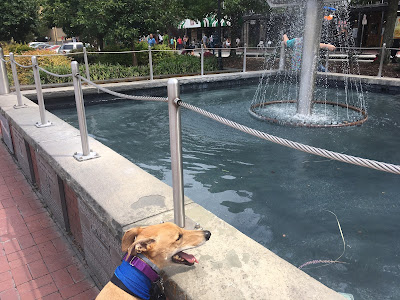Our home town is Smyrna, GA, so I'm always walking Rip around the historic areas of this small city. One of his favorite places is Smyrna Memorial Cemetery, due to the many squirrels he can chase! It's a nice quiet area in the middle of a congested area.


You'll see that Rip is in front of a CSA soldier's grave with the last name of Hamby. I made a point of seeing this grave today. The news of the last few days, from Charlottesville to Durham, even here in Atlanta, has made me think more and more of Confederate imagery in our public places. This gravestone has been in this cemetery since 1896. The Durham statue of a Confederate soldier was installed in 1924. A statue defaced in Piedmont Park was dedicated in 1911 as a symbol of peace between North and South. I think two things are being forgotten in this current haste to eliminate all symbols of racism and bigotry. First, these are symbols that represent the history of this country, both good and bad. We cannot simply forget what happened in the southern U.S. between 1861 and 1865, as it is clearly still relevant in our current nation. Removing the images of Robert E Lee, Jefferson Davis, or the common Confederate soldier will not stop police profiling, African-American incarceration, or the mainstream media's depiction of minorities in this country. As Barbara Fields indicated in Ken Burns' Civil War, "the Civil War is still being fought and, regrettably, it can still be lost." All this current stream of emotion serves is to mask the real problems in this country.
This is my second point. Symbols are important, but they are not as important as giving a fellow human being a helping hand, a shoulder to lean on, or a friendly ear. Modern America has forgotten the axioms of Martin Luther King Jr., Henry Wallace, and Mahatma Gandhi. There are so many social issues in this country that need to be addressed. Why can't we focus our energies on homelessness, addiction, education, pollution, crime? These are problems that need to be addressed now, and are much larger issues than a statue in a city square that most people don't pay attention to on a daily basis. The actions of the white supremacists in Charlottesville were despicable, and that kind of hate has no place in this country. Anger is not a bad thing, but hate is. The groups that are angry about Confederate imagery should think about the real source of that anger, and focus it accordingly. I believe modern America has a problem with focus because of all of the external stimuli we are bombarded with every day. But, if we can focus our passion for change and keep our eyes on the true prizes, we'll have a great nation to live in. Thanks for letting me ramble!


























